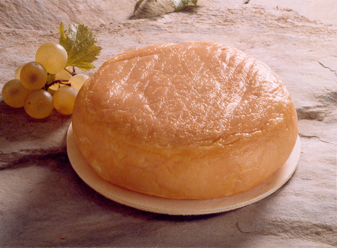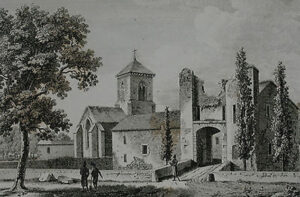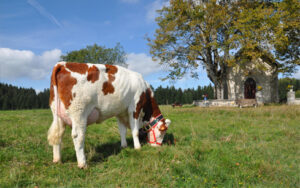
During the Congress of Vienna in 1815, 49 European cheeses were rated in a competition organised by Talleyrand. Époisses is ranked second, behind Brie.
The name of the cheese, Époisses, comes from the town where it originates. Époisses cheese was imported to the court by the Count of Guitaut, one of the gentlemen of Louis XIV’s wardrobe, and became very popular there. Later, Napoleon I was also to appreciate it, as well as the famous Chambertin wine, which he would never forget. It is true that the two form a perfect alliance.
Époisses cheese takes the form of a medium-thick disc 10cm in diameter, 4cm thick and weighing approximately 300g. It is matured for two to three months in a damp cellar with washings. Nevertheless, the maturing process only lasts one month if it is done in marc de Bourgogne.
Smooth or slightly wrinkled rind with an ivory-orange to brick-red colour, depending on its degree of ripeness. This colour is due exclusively to the pigmentation of the surface bacteria, in particular the red ferments, the use of colouring agents being prohibited. Its paste is light beige around the edges and white in the middle. Penetrating and healthy smell, the nose is strong, bouqueted, with aromas of undergrowth. A soft touch with resistance, very high to high, depending on age. In the mouth, the paste is supple, unctuous, never too strong. Its taste is frank, subtle, balanced, with light notes of dried fruit.

Epoisses cheese is particularly tasty:
The geographical area of the Époisses cheese appellation covers a large western part of the Côte d’Or, two cantons of the Haute-Marne and three cantons of the Yonne department. It corresponds to the natural grasslands associated with the marly soils of the Jurassic geological layers. The Lower Jurassic (Lias) constitutes the historical core of the production area (Époisses plain in Côte d’Or and Terre Plaine in Yonne).

From the beginning of the 16th century, the village of Époisses was home to a community of monks to whom oral tradition attributes the paternity of Époisses cheese. When she left the village some two centuries later, she bequeathed a valuable legacy to the peasant women of the valley: the recipe for making it. And, it is in the small farms of the Auxois, that this cheese The history and development of this exceptional company is based on this.
By taking over the production of “past” cheese, the region’s women farmers gradually established an original know-how, improved the quality of the products, and then made their product known to the outside world, which then peacefully earned its letters of nobility.
Numerous administrative documents from the beginning of the 19th century thus attest to a developed cheese-making activity specific to the Époisses valley.
The cheese is already renowned; it is exported to Paris and to several departments. Many authors are interested in how it is made.
The archives thus bear witness to a unity of manufacturing methods, based on the know-how of slow, lactic coagulation, associated with frequent washing of the cheese with marc de Bourgogne.
The good value of the cheeses encourages the development of this activity. It is estimated that there were over 300 farms producing Époisses cheese around 1900. Cheese competitions on the occasion of agricultural fairs and shows are organised with great success in the region.
The 1914-1918 war, by taking away part of the male population of the Auxois, left the women alone to work in the fields; as they no longer had the time to look after the Époisses cheeses and to go and sell them on the local markets, they started to abandon the production. The decline is underway.
After the war, the comices did not take over the cheese exhibitions and competitions. The labour-intensive production of Époisses cheese is not compatible, in the eyes of the new generations, with the development of agriculture.
The disappearance of farmhouse cheese was effective between 1954 and 1956.
It was at this time that a farming couple decided to relaunch the production of Époisses cheese, by mobilising the know-how of those in the region who still knew how to make Époisses cheese.
Gradually, the cheese found its fans, aroused vocations on the part of cheese-makers, and developed, culminating in its official recognition in 1991 as an Appellation d’Origine Contrôlée.

Today, three breeds of cattle are used for the production of Époisses cheese: the Brune, mainly in the Châtillonnais, the traditional cradle of the breed; the French Simmental, on the Langres plateau and in the steep valleys of the northern Auxois; and the Montbéliarde, in the southern Auxois and in the Dijon backcountry. These breeds were selected because of their long-standing presence in the production region, and because of their high cheese quality. Dairy farmers are implementing practices that strengthen forage autonomy and the link to the land
© 2023 Château d’Epoisses. | All rights reserved
Adresse
1 Rue de Semur, 21460 Époisses, Bourgogne-Franche-Comté
visites@chateaudepoisses.com
03 80 96 40 56